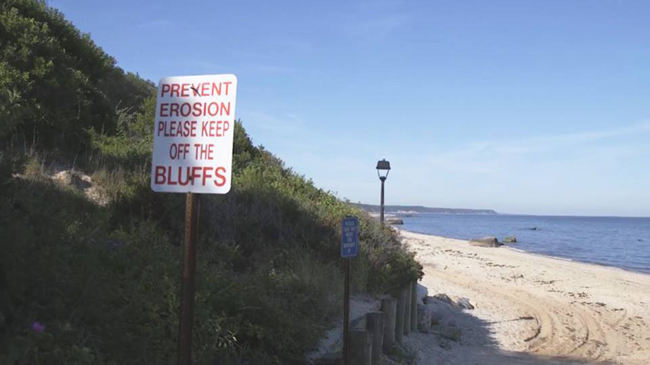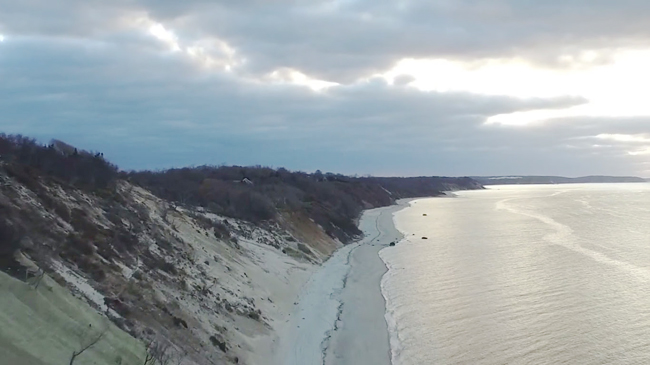— By Chris Gonzales, Communications Specialist, New York Sea Grant
Stony Brook, NY, July 17, 2017—Along Long Island’s coastline, impressive bluffs reach scores of feet high, towering over the ocean waves and sandy beaches.
Yet toppled trees, gullies, overhanging lips of vegetation and vertical faces are all signs of bluff erosion that can affect development on top of the bluff. Houses crumble down cliff faces and land collapses into the sea, never to be recovered. The economic, not to mention emotional, toll of these losses can be significant.
So, how are shoreline property owners coping with bluff erosion? This dramatic problem in New York’s coastal regions and waterways is the focus of a newly-released half-hour long video, which can be viewed above. The production was led by the Suffolk County Soil and Water Conservation District in cooperation with New York Sea Grant and the Natural Resources Conservation Service Cape May Plant Materials Center.

Signage encourages beach goers to keep off the bluffs in an effort to help prevent erosion. Credit: Cornell Extension Marine Program
Bluff erosion—a natural process that has been occurring for thousands of years—is important for supplying sand to beaches on Long Island Sound. If possible, this natural process should be allowed to continue. However, bluff erosion often threatens homes and other structures built on the bluff. When this happens there are a variety of approaches that can be considered for dealing with erosion.
The best options are to place development far enough landward from the edge of the bluff where it is not threatened by erosion or move structures and development away from the bluff edge. When these are not possible, a decision should be made to try and prevent erosion. Property owners must first try identifying the processes causing erosion by monitoring what is happening on the bluff face. They should look for warning signs like erosion at the base of the bluff caused by waves, gaps in vegetation and rills and gullies on the bluff face. Property owners can cope with erosion by protecting the toe of the bluff, and planting diverse vegetation on the bluff face. They should aim to preserve the “angle of repose,” ideally a 1:3 ratio of bluff rise to reach, although many bluffs are naturally steeper.
Bluffs, formed by glacial deposits over 20,000 years ago, represent geologically and culturally significant features and therefore are highly regulated under New York State law.

Bluffs rise above Long Island Sound. Credit: Cornell Extension Marine Program
“At the toe, vegetation alone cannot stand up to wave action of Long Island Sound or the Atlantic Ocean,” said Jay Tanski, a recently-retired senior coastal processes specialist at New York Sea Grant. “If the goal is to stop the erosion of the bluff some type of structure will be needed if waves are reaching the bluff base.”
There are a variety of structures that can be used to stabilize the toe, including rock revetments and wooden bulkheads. Due to the fact that the bluffs are highly regulated and susceptible to human intrusion, property owners must seek professional advice when considering the use any erosion control measure. This is because structures are very expensive and can create other problems if not sited, designed and built properly.
On Long Island’s bluffs, experts recommend planting dense stands of vegetation on bluff faces using a diversity of salt-tolerant species such as beach grass and seaside goldenrod. See the above video for other plants they recommend.
Also, large trees at the top of bluffs should be cut near ground level. Gently lower trunks and branches rather than dropping debris on the top or down the bluff face. That could cause sudden and catastrophic erosion. Debris on the face could form a mulch layer that suffocates vegetative life.
Another caution: Humans should not walk down bluff faces without an elevated stairway as it could lead to hazardous instability or collapse.
Bluff or beach access stairwell maintenance should also be done by a professional.
Bluff erosion is a natural process. However, this video shows how property owners can protect their homes, investment and peace of mind, not to mention the bluff’s natural beauty.
More Info: New York Sea Grant
New York Sea Grant (NYSG), a cooperative program of Cornell University
and the State University of New York, is one of 33 university-based
programs under the National Sea Grant College Program (NSGCP) of the
National Oceanic and Atmospheric Administration (NOAA). The NSGCP
engages this network of the nation’s top universities in conducting
scientific research, education, training and extension projects designed
to foster science-based decisions about the use and conservation of our
aquatic resources. Through its statewide network of integrated
services, NYSG has been promoting coastal vitality, environmental
sustainability, and citizen awareness about the State’s marine and Great
Lakes resources since 1971.
New York Sea Grant maintains Great Lakes offices at SUNY Buffalo, the
Wayne County Cooperative Extension office in Newark and at SUNY Oswego.
In the State's marine waters, NYSG has offices at Stony Brook University
and Stony Brook Manhattan, in the Hudson Valley through Cooperative
Extension in Kingston and at Brooklyn College.
For updates on Sea Grant activities: www.nyseagrant.org has RSS, Facebook, Twitter, and YouTube links. NYSG produces a monthly e-newsletter, "NOAA Sea Grant's Social Media Review," via its blog, www.nyseagrant.org/blog. Our program also offers a free e-list sign up via www.nyseagrant.org/coastlines for its flagship publication, NY Coastlines/Currents, which is published 1-2 times a year.